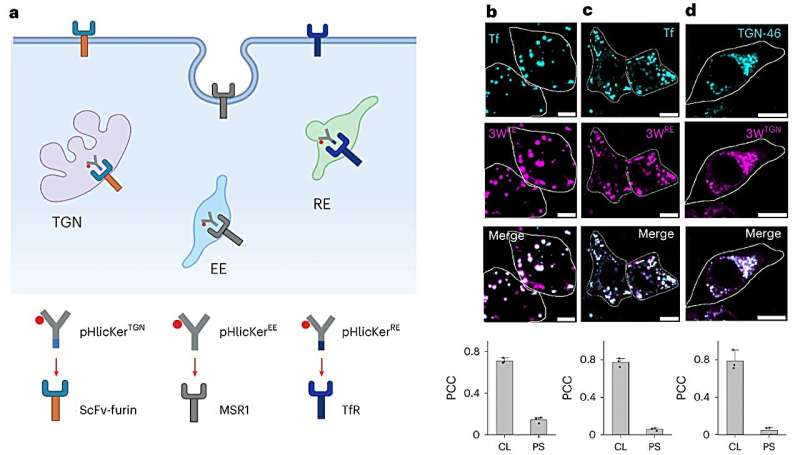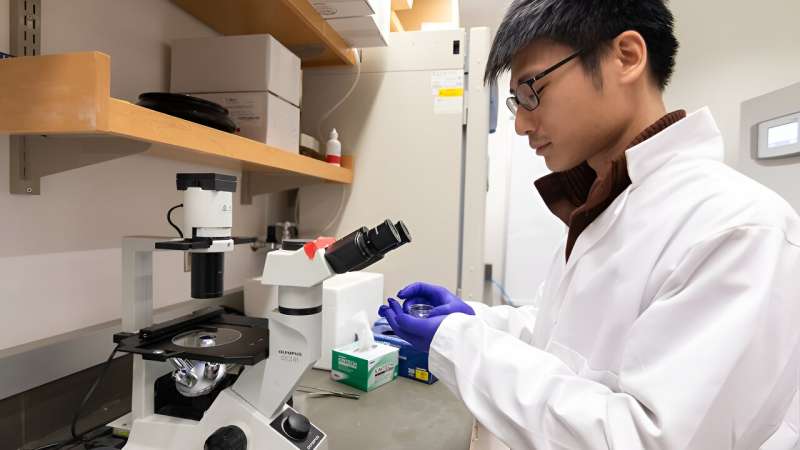This article has been reviewed according to Science X's editorial process and policies. Editors have highlighted the following attributes while ensuring the content's credibility:
fact-checked
peer-reviewed publication
trusted source
proofread
Chemists create sensors to track potassium and sodium in cell organelles

Two studies by scientists at the University of Chicago have demonstrated a new way to look into the inner workings of cells—in particular, to track the flow of ions inside the many tiny organelles inside the cell.
Their findings not only show these sensors can work, but also revealed evidence that organelles do regulate ions—a biological question which had been previously debated.
The technique can help reveal new information about how cells function, which could boost our understanding of and treatments for diseases and disorders such as Parkinson's. Both studies have been published in the journal Nature Biotechnology.
'An underexplored area'
We know that cells need ions like sodium and potassium to function—that's why you need to drink not just water, but electrolytes when you run a marathon. Cells use these ions for many functions, like signaling and muscle contractions, so they keep very tight control over the flow of ions in and out of the cell.
But we know less about the role of ions inside the individual parts inside the cell. These are the organelles—the Golgi bodies, the lysosomes, the mitochondria, etc., that each carry out special functions.

"This is an underexplored area, because we haven't had the tools to measure ions inside organelles," said UChicago chemist and co-author Junyi Zou. "But there are good reasons to believe ion concentrations are important inside organelles."
Zou and colleague Palapuravan, who uses one name, are both members of the laboratory of UChicago Prof. Yamuna Krishnan, who specializes in creating tiny "devices" made out of DNA to investigate the inner workings of cells.
Because they are made of DNA, they are biologically compatible and nontoxic, so they can be used to peek in on live cells as they go about their business—a significant advantage over more commonly used methods that cannot be used in vivo. The devices can also withstand pH levels that would normally disable other kinds of sensors.
For this task, To achieve this feat, the team needed to get the sensors to reach a specific kind of organelle inside particular cells. To do so, they attached a molecule that lets the sensors hitch-hike on a protein that normally shuttles between the cell membrane and a specific organelle as part of normal function.
Once inside the organelle, the sensors react with nearby ions and cause them to light up, which scientists can see under a microscope. "This allows us to quantify the level of ions by measuring the brightness of the sensor," explained Zou.
Zou and Palapuravan each focused on a different ion and a different kind of organelle.
Palapuravan focused on tracking potassium inside organelles that form part of the cell's recycling machinery. These organelles, called recycling endosomes, are responsible for sorting and moving ion channels to and from the cell surface, but no one had tested whether or not these ion channels were actively regulating ion levels anywhere else in the cell.
The results were clear. "The ion channels are definitely active in organelles," said Palapuravan.
The finding opens up a new avenue of inquiry to find out the precise role of ion concentrations.
"We know that ion channels are involved in diseases such as Parkinson's, but pharmaceutical drugs to date generally target ion channels that are only on the plasma membrane, and not in organelles," said Palapuravan. "Their activity inside organelles may turn out to have interesting new roles and new drugs can be developed."
The role of lyosomes
Zou's study, meanwhile, focused on tracking sodium ions inside an organelle called the lysosome. Lysosomes break down cell debris and are important in several diseases, but no one had managed to get a functioning sodium sensor inside.
Using the new sensors, the team found evidence that the lysosomes were indeed actively regulating cellular sodium, suggesting that lysosomes play an important role in helping cells regulate their sodium levels.
They also found evidence that the amount of sodium in the lysosome is important for an organism to survive exposure to high salt levels; Worms without lysosomal sodium transporting proteins were less likely to survive a high-salt environment. "It's an interesting connection to the entire organism's metabolism," Zhou said.
In future studies, the sensors should be useful to explore the role ions and ion channels play within cells—opening the doors for new fundamental understanding of biology and disease.
"I'm very excited about the fact our sensors have revealed that sodium and potassium—ions that are so important in health and disease—are actively moving across organelle membranes," said Prof. Yamuna Krishnan, the senior author on both papers.
"Together, both findings change our perception of organelle membranes from being inert bags whose purpose is to simply ferry their contents to a destination, to one where they're fizzing with activity while doing so—thereby letting their insides communicate with the outside."
More information: Palapuravan Anees et al, Detecting organelle-specific activity of potassium channels with a DNA nanodevice, Nature Biotechnology (2023). DOI: 10.1038/s41587-023-01928-z
Junyi Zou et al, A DNA nanodevice for mapping sodium at single-organelle resolution, Nature Biotechnology (2023). DOI: 10.1038/s41587-023-01950-1
Journal information: Nature Biotechnology
Provided by University of Chicago





















